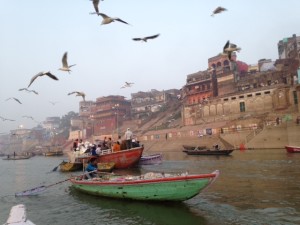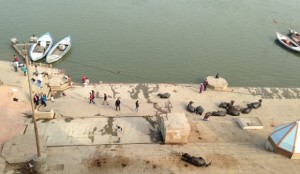 The waiter is hovering close to our table on the rooftop patio of the Suryauday Haveli hotel, one eye on the sky, one eye measuring the likelihood of a tip.
The waiter is hovering close to our table on the rooftop patio of the Suryauday Haveli hotel, one eye on the sky, one eye measuring the likelihood of a tip.
“It’s kite season,” he says, and we hold our hands to our brows and squint up at the fluttering squares of blue, magenta, and gold. They duck and shimmy, dive, then dart upwards again. We can count 10, 20 kites, maybe more.
On the ghats below, a man in a torn dress shirt and a lungi hoisted up so his boney knees are exposed is beating laundry against a slab of stone. Slap, slap, slap: the fabric twists tighter each time he throws it over his head then back at the wet stone. The waiter is only interested in the kites above, clucking softly when one plunges towards the scraggle of wires that run between two tall lampposts. Pigeons rise as one, beating their wings, then settle back on the wire when the kite wheels skywards once again.
Below, the grey-brown Ganges sucks at the calves of the laundry man—his feet must be freezing, but we don’t know for certain. We’re sure as hell not going to test the temperature: only a crazy person would stick a digit into this filthy water. Every now and then the man steps up onto the ghats to fetch another garment, another swath of colourful cloth. He hands the wrung out items to a woman who lays them out on the broad steps to dry: long saris, oversized tunics, blocky pants, each leg wide as a sleeping bag. From above, they look like cut-out costumes for paper dolls.
“How do the colours stay so bright?” I turn to ask the waiter. But he’s gone, retreated silently down the stairs leaving us six plump, piping-hot samosas on a plate garnished with shredded beet and carrots. We pluck the samosas off the raw vegetables; we aren’t taking any chances. “Everyone gets sick in Varanasi,” people warned before we came. We are sticking to foods that have the shit cooked out of them. Literally.
 Someone has chained a lone bull to a ring in the cement close to the base of our hotel. The chain is scarcely long enough for the bull to stand so he lies placidly enough, his own crap heaped in piles around him. Later this evening, our guidebook explains, people will come and collect these mounded turds, form them into patties in tomorrow’s mid-day heat, then cart them off to market to be sold as fuel for fires. The female buffalo are lying on a lower ghat, black as inkblots in the late-day sun, jagged spines like mountain ridges down their backs. We say: we should bring them our vegetable garnish, then forget.
Someone has chained a lone bull to a ring in the cement close to the base of our hotel. The chain is scarcely long enough for the bull to stand so he lies placidly enough, his own crap heaped in piles around him. Later this evening, our guidebook explains, people will come and collect these mounded turds, form them into patties in tomorrow’s mid-day heat, then cart them off to market to be sold as fuel for fires. The female buffalo are lying on a lower ghat, black as inkblots in the late-day sun, jagged spines like mountain ridges down their backs. We say: we should bring them our vegetable garnish, then forget.
We descend again to wander in the bruised-blue light. Boys trot beside us, plucking at our sleeves: boat ride, sir? Boat ride madam? But we went out in the rowboats yesterday evening and again today at dawn, bobbing too close to the cremation fires where families were laying out their dead, then circling around and around the bodies as they burned. By some estimates, over 100,000 cremations take place on the banks of the holy Ganges each year, with Varanasi sending the vast majority of these earthly vessels to the gods every hour of every day. The city is home to special hospices where people come towards the end of their lives, hoping they are lucky enough to die on the banks of this river. It takes roughly three hours to burn a corpse to ash.
And does the whole body burn? we want to know. Our guide, Avi, is unfazed by the question. All of these questions have been asked of him before.
“Only the hipbones of the ladies and the skulls of the men,” Avi says. “These sometimes don’t burn completely.” Had he asked us to guess, I might have got this at least partly correct.
Dusk is falling, but men are still standing around, hip-deep, soaping their bellies and armpits and shouting to one another in Hindi. A woman fills a metal bucket with water that she carries up the ghats balanced on her head. Children play cricket on a narrow stretch of stone at the base of the buildings, shrieking and scrambling as the thwack of the bat sends their ball towards the water. We tourists thread through it all, every one of us giving off an air of strained nonchalance. As if we’ve shown up hungover, wearing the wrong clothes, to someone else’s funeral and we don’t know where to look or how to behave. All of that being more or less true.
 Back at our hotel, the bull is gone. A boy is herding the buffalo up the steps towards town, tapping them lightly with a stick to urge them on. As we approach, one lifts her tatty tail and we watch, astounded, as the boy starts to stroke at the cow’s anus then, as the shit starts to slide out, slips his hand in to help scoop it out.
Back at our hotel, the bull is gone. A boy is herding the buffalo up the steps towards town, tapping them lightly with a stick to urge them on. As we approach, one lifts her tatty tail and we watch, astounded, as the boy starts to stroke at the cow’s anus then, as the shit starts to slide out, slips his hand in to help scoop it out.
We retreat again to the rooftop, but we’re still riveted, tethered like kites to everything going on down below. We take up our chairs under the swirling shapes and wait for other tourists to join us, so we can all look down at life along the river, ogle and laugh. Swap stories about our travels that are too big and implausible to keep to ourselves.
You’ve been visiting Varanasi. For more of this journey, check out Agra, Delhi, and Jaipur.